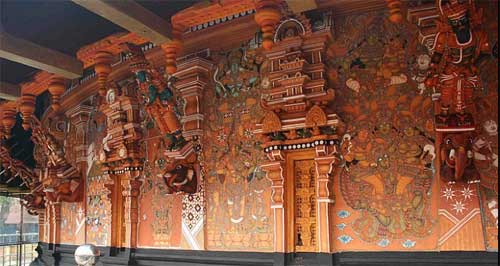Kerala mural painting is a classical art form from the state of Kerala, India. It is known for its intricate designs, vibrant colors, and depiction of Hindu mythology. These murals adorn the walls of temples and palaces in Kerala.

Image source: Wikipedia Buy Kerala Mural Painting
Origin and History
Kerala mural painting has a long history dating back to the 9th century. It flourished during the reign of the Chera, Chola, and Pandya kings. The art was primarily used to decorate temple walls and narrate stories from Hindu mythology.
The Process
Creating a Kerala mural art involves several steps:
- Preparing the Surface: Artists use lime-plastered walls as the base.
- Drawing the Outline: They use fine brushes to draw detailed outlines.
- Coloring: Natural colors made from minerals, vegetables, and other organic materials are applied.
- Detailing: Artists add intricate details and shading to bring the paintings to life.
Themes and Motifs
Kerala mural art paintings depict various themes:
- Hindu Gods and Goddesses: Common depictions include Shiva, Vishnu, and Krishna.
- Mythological Stories: Scenes from epics like Ramayana and Mahabharata.
- Nature: Detailed depictions of animals, birds, and natural elements.
- Spiritual Themes: Stories of saints and divine beings.
Unique Characteristics
Kerala mural paintings have special features:
- Vibrant Colors: Artists use bright and natural colors.
- Detailed Work: The paintings are known for their intricate designs and fine brushwork.
- Large Scale: Murals often cover large wall spaces in temples and palaces.
- Symbolism: Many elements in the paintings have symbolic meanings related to Hinduism.
Modern Relevance
Today, Kerala mural paintings are admired worldwide. They are used in home decor, hotels, and public spaces. Efforts are being made to preserve and promote this ancient art form through workshops and exhibitions.
FAQs
What is Kerala mural art?
Kerala mural art is a traditional Indian art form from Kerala, known for its intricate designs, vibrant colors, and depiction of Hindu mythology.
Where did Kerala mural painting originate?
Kerala mural originated in the state of Kerala, India, around the 9th century.
What materials are used in Kerala mural art?
Artists use lime-plastered walls as the base and natural colors made from minerals, vegetables, and organic materials.
How is a Kerala mural art made?
Artists prepare the surface, draw detailed outlines, apply bright natural colors, and add intricate details and shading.
What themes are common in Kerala mural art?
Common themes include Hindu gods and goddesses, mythological stories, nature, and spiritual themes.
What makes Kerala mural art unique?
Kerala mural paintings are unique for their vibrant colors, intricate designs, large scale, and symbolic meanings.
Can Kerala mural art be used for home decor? If Yes! How can I buy
Yes, Kerala mural art can be adapted for home decor, adding a touch of traditional art to modern spaces. You can buy from Amazon India
Where can I see authentic Kerala mural art?
Authentic Kerala mural paintings can be seen in temples and palaces in Kerala. You can also find them in museums and galleries.
How is Kerala mural art being preserved today?
Kerala mural art is preserved through workshops, exhibitions, and by promoting traditional artists.
Are there modern adaptations of Kerala mural painting?
Yes, modern artists create new works inspired by Kerala mural painting, blending traditional and contemporary styles.
Kerala mural painting is a vibrant and intricate art form from India. Its depiction of Hindu mythology and use of natural colors make it unique and captivating. Supporting Kerala mural art helps preserve this ancient tradition for future generations.
View India’s popular art form
- Madhubani Painting: Also called Mithila Painting. Vibrant folk art from Bihar, known for intricate patterns and storytelling.
- Warli Art: Tribal art form from Maharashtra, characterized by simplistic yet expressive depictions of daily life.
- Tanjore Painting: Classical South Indian art form renowned for its rich use of gold foil and vibrant colors.
- Kalamkari Painting: Ancient art form from Andhra Pradesh, using natural dyes and intricate storytelling on cloth.
- Mughal Painting: Detailed miniature paintings from the Mughal era, showcasing courtly scenes and historical events.
- Pattachitra Painting: Traditional art form from Odisha, featuring bold lines, vibrant colors, and mythological themes.
- Gond Painting: Tribal art form from Madhya Pradesh, celebrated for its vibrant colors and intricate patterns inspired by nature.
- Rajasthani Miniature Painting: Diverse styles of miniature paintings from Rajasthan, depicting courtly life, landscapes, and religious themes.
- Thangka Painting: Tibetan Buddhist art form practiced in parts of India, revered for its spiritual significance and intricate details.
- Kangra Painting: Miniature painting style from Himachal Pradesh, known for its romantic themes and delicate brushwork.
- Pichwai Painting: Devotional art form from Rajasthan, depicting Lord Krishna and his various leelas.
- Kalighat Painting: Folk art from Bengal, characterized by simple lines, bold colors, and depictions of everyday life and deities.
- Mysore Painting: Traditional art form from Karnataka, known for its delicate brushwork and intricate details.
